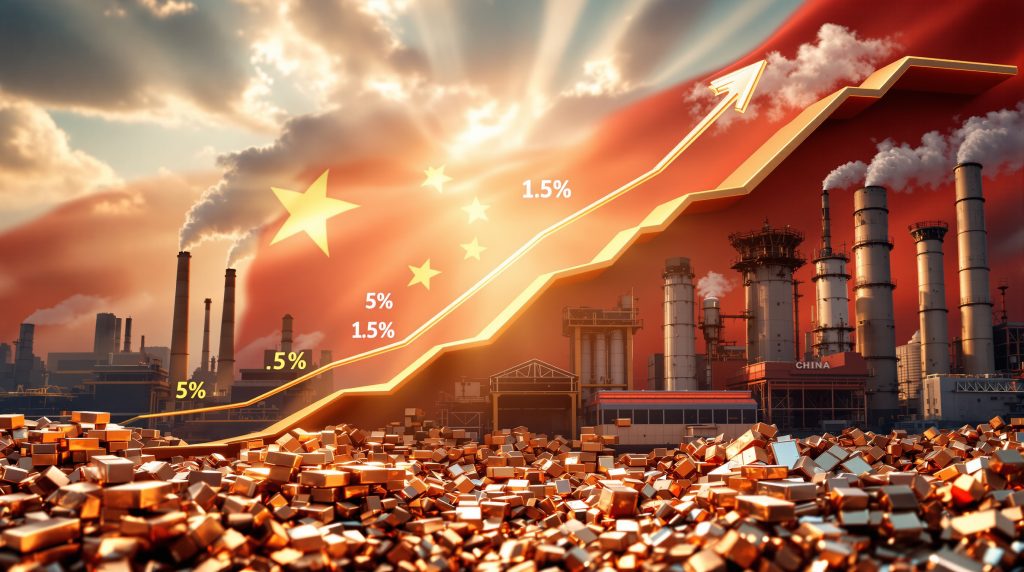China's Strategic Pivot: Reducing Metal Production Targets to Combat Overcapacity
China has fundamentally shifted its approach to metals production, moving away from volume-driven growth toward quality-focused development. The Ministry of Industry and Information Technology recently announced a dramatic reduction in production targets for key non-ferrous metals, signaling a strategic pivot that will reshape global metal markets.
Understanding the 70% Reduction in Growth Expectations
In a significant policy shift, China has slashed annual output growth targets for its 10 primary non-ferrous metals from 5% to just 1.5% for 2025-2026. This represents a 70% decrease in growth expectations and marks a substantial departure from China's previous expansion-focused industrial policy.
According to the Ministry of Industry and Information Technology's statement on September 29, 2025, the reduced targets apply to copper, aluminum, and eight other key non-ferrous metals. This scaled-back ambition underscores Beijing's effort to pursue industry upgrades and decarbonization while addressing critical overcapacity issues.
The change comes after years of rapid capacity additions that have created periodic gluts and profit squeezes for producers across multiple metal categories. By constraining production growth, Chinese authorities aim to create a more balanced and sustainable industry structure.
The Ministry's New Vision for Sustainable Metal Production
The revised growth targets reflect a comprehensive policy reorientation prioritizing sustainability over volume. Rather than focusing on maximizing output, the new approach emphasizes efficiency improvements, environmental protection, and the development of high-value products.
This shift aligns with China's broader economic transformation strategy, moving from being the world's factory toward becoming a leader in advanced manufacturing and technological innovation. For the metals industry, this means developing sophisticated capabilities rather than simply expanding production capacity.
How Will Reduced Production Targets Affect Global Metal Markets?
Market Reactions to China's Policy Shift
The announcement triggered immediate positive responses in global metal markets. Copper prices rose 1.1% following the news, trading at $10,297 per ton on the London Metal Exchange. Other LME metals, including aluminum and zinc, also showed gains as traders anticipated tighter supply conditions.
Chinese metal producers saw significant stock price increases, with Jiangxi Copper Co. gaining up to 5% and Aluminum Corp of China Ltd. climbing more than 5% in Hong Kong trading. These market movements suggest investors view the policy shift as beneficial for producer profitability and overall market stability.
Industry analysts note that reduced Chinese output growth could help balance global markets that have faced periodic oversupply challenges. With China representing approximately 60% of global aluminum production and over 40% of refined copper output, even small changes in Chinese production targets can have outsized effects on global markets.
Supply-Demand Dynamics Under the New Growth Paradigm
The reduced growth targets could significantly alter global metal availability through 2026. With Chinese production expansion slowing dramatically, supply growth will likely struggle to keep pace with demand, particularly in metals critical to energy transition technologies.
For copper specifically, which faces growing demand from renewable energy, electric vehicles, and grid infrastructure, the constrained production growth could accelerate already-brewing supply concerns. Industry experts project that global copper demand could exceed supply by over 4 million tons annually by 2030 if new mining projects aren't developed. Recent copper price insights indicate this supply-demand imbalance could lead to record prices in coming years.
Aluminum markets may experience similar tightening, though the effects might be less pronounced due to greater production capacity outside China. Nevertheless, the policy could reduce the periodic price pressure that has characterized aluminum markets in recent years.
Why is China Reining in Its Metals Industry Now?
Domestic Overcapacity Concerns Driving Policy Change
The reduced growth targets directly address China's persistent problem with industrial overcapacity. Rapid expansion of production facilities over the past decade has led to utilization rates below optimal levels in multiple metal categories.
In aluminum, for example, capacity utilization has periodically fallen below 80% during market downturns, creating economic inefficiencies and eroding producer margins. Similar patterns have affected other non-ferrous metals sectors, creating periodic market gluts that destabilize prices.
By constraining production growth, Beijing aims to encourage consolidation and operational efficiency rather than further capacity expansion. This approach should gradually improve capacity utilization rates and create a healthier industry structure over time.
Environmental and Decarbonization Imperatives
Environmental considerations represent another crucial driver behind the reduced targets. Metal production, particularly aluminum and copper refining, is highly energy-intensive and has contributed significantly to China's carbon footprint and air pollution challenges.
By limiting production growth, China can better control emissions from the metals sector while focusing on operational improvements that reduce environmental impact. This aligns with China's broader climate commitments, including its pledge to reach peak carbon emissions before 2030 and achieve carbon neutrality by 2060.
The metals industry will be expected to contribute to these goals by improving energy efficiency, shifting to cleaner energy sources, and developing more environmentally sustainable production processes. The reduced growth targets make these transitions more manageable by limiting the expansion of energy-intensive capacity. Many mining operations are exploring renewable-energy mining strategies to reduce their environmental footprint.
How Does Recycling Factor Into China's New Metal Strategy?
The Ambitious 20-Million-Ton Recycling Target
While constraining primary metal production growth, China is simultaneously setting ambitious recycling targets. According to the Ministry's statement, China aims for annual secondary metal output to exceed 20 million tons by 2026, representing a significant increase in recycled metal utilization.
This dual approach of limiting primary production while boosting recycling reflects a sophisticated strategy to meet metal demand with lower environmental impact. Recycling aluminum, for instance, requires only about 5% of the energy needed for primary production from bauxite, offering substantial environmental benefits.
The policy emphasizes broadening support for the reuse of waste batteries, solar panels, and other scrap materials, creating a more circular material economy. Recent battery recycling breakthrough initiatives demonstrate how the industry is innovating in this space. This approach also enhances resource security by reducing dependency on imported ores and refined metals.
Creating a Circular Economy for Critical Materials
China's recycling push extends beyond traditional metals to include critical materials found in high-technology products. The policy specifically mentions waste batteries and solar panels, which contain valuable metals like lithium, cobalt, and silver.
By developing advanced recycling capabilities for these complex products, China aims to recover valuable materials that would otherwise be lost while reducing the environmental impact of disposal. This approach also addresses growing concerns about critical material availability for clean energy technologies.
The development of a circular economy for metals will require substantial investment in collection systems, processing technologies, and regulatory frameworks. China appears committed to making these investments to secure its resource future while meeting environmental objectives.
What's China's New Focus Beyond Production Volume?
The Push Toward High-End Metal Products
Rather than competing primarily on production volume, China is reorienting its metals industry toward higher-value products. The policy roadmap specifically mentions pursuing breakthroughs in ultra-high purity metals and advanced rare earth materials processing.
This value-added approach aims to capture more economic benefit from each ton of metal produced while developing products that face less direct competition in international markets. Ultra-high purity metals, for example, command premium prices for applications in semiconductors, aerospace, and other advanced industries.
The strategy represents a natural evolution for China's industrial base as labor costs rise and environmental requirements tighten. By developing sophisticated product capabilities, China can maintain industrial competitiveness while transitioning away from energy-intensive commodity production.
Building Resilience Against Trade Measures
The new policy explicitly mentions helping companies cope with trade measures by foreign countries, acknowledging the growing trade tensions facing Chinese metal exporters. Recent years have seen increasing US-China trade tensions that have disrupted traditional supply chains, as reported by Reuters.
By shifting toward higher-value products and enhancing global competitiveness, China aims to develop market positions less vulnerable to trade restrictions. Products with unique specifications or technological advantages typically face fewer trade barriers than commodity-grade materials.
This resilience-building approach involves diversifying export markets, developing domestic consumption, and creating products with competitive advantages beyond price. The policy reflects Beijing's recognition that future industrial success requires adaptation to a changing global trade environment.
How Will This Policy Shift Impact Global Supply Chains?
Implications for Metal-Dependent Industries Worldwide
The reduced growth targets will likely have cascading effects through global supply chains for metal-intensive products. Industries including automotive manufacturing, electronics, construction, and renewable energy could face adjusted material availability and pricing.
For companies that have built business models assuming continued rapid growth in Chinese metal output, the policy shift may require strategic adjustments. Supply chain managers will need to consider alternative sourcing strategies, particularly for specialized metal products currently dominated by Chinese suppliers.
The impact will vary significantly by metal category and product type. While basic commodity metals may see modest price increases, the most significant disruptions could occur in specialized products where production is concentrated in China and alternatives are limited.
Opportunities for Non-Chinese Producers
The constrained growth in Chinese production could create openings for metal producers in other regions. Companies with expansion projects or idle capacity may find improved market conditions as Chinese output growth slows.
Metal production projects outside China may see enhanced economic viability as supply-demand balances tighten. This could accelerate development timelines for mining and refining projects that have struggled to attract investment in recent years.
However, developing significant new production capacity requires substantial time and capital investment. Even with improved market conditions, it may take years for non-Chinese production to expand enough to fully offset the reduced growth in Chinese output.
What Does This Mean for Global Decarbonization Efforts?
Balancing Metal Supply with Clean Energy Transitions
The policy shift comes at a critical time for global clean energy transitions, which require substantial quantities of copper, aluminum, and other metals. Renewable energy systems typically require 4-5 times more copper per megawatt than conventional power generation, while electric vehicles use 3-4 times more copper than internal combustion vehicles.
The reduced growth targets could create tension between metal availability and decarbonization goals if alternative supply sources aren't developed. Energy transition planners may need to consider material efficiency, substitution options, and expanded recycling to meet metal requirements.
This dynamic highlights the complex interconnections between industrial policy, resource availability, and climate objectives. Successful decarbonization will require coordinated approaches to ensure critical material availability without compromising environmental goals.
Environmental Trade-offs in Global Metal Production
If metal production shifts from China to other regions in response to Chinese constraints, the net environmental impact will depend on the production standards and energy sources in those alternative locations. Production in regions with less stringent environmental controls or more carbon-intensive energy could potentially increase global emissions.
This presents a complex challenge for policymakers and industry leaders seeking to balance material availability, economic development, and environmental protection. International coordination on production standards and emissions reductions becomes increasingly important in this context.
The most environmentally positive outcome would involve both improved efficiency in Chinese production and the development of low-carbon production capacity in other regions, supported by dramatically expanded recycling globally.
Frequently Asked Questions About China's Metal Production Policies
Will These Changes Lead to Higher Global Metal Prices?
The reduced growth targets will likely create upward pressure on metal prices, though the magnitude will vary by metal category. Copper, which already faces supply constraints, could see more significant price effects than metals with greater production capacity outside China.
Market analysts project that copper prices could potentially rise 10-15% over the medium term as the effects of constrained Chinese production compound existing supply challenges. Aluminum may see more modest price increases of 5-8%, as production is more globally distributed.
However, price effects will be moderated by demand factors, including global economic growth rates and the pace of energy transition investments. Significant economic slowdowns could offset the price effects of constrained supply growth.
How Will China Maintain Industrial Growth With Lower Metal Output?
China's strategy for continued industrial growth despite lower metal output growth relies on several approaches:
- Moving up the value chain to capture more economic value from each ton of metal produced
- Expanding the circular economy through enhanced recycling and material reuse
- Improving production efficiency to extract more value with fewer resources
- Focusing on advanced manufacturing sectors that generate more GDP per unit of material input
- Developing innovative material technologies that reduce material intensity while maintaining performance
This multi-faceted approach reflects China's broader economic transformation goals, moving from resource-intensive growth toward innovation-driven development with lower environmental impact.
Expert Outlook: The Future of China's Metal Industry
Five-Year Projections for Key Metal Categories
Industry experts project that China's copper production will grow from approximately 10.5 million tons in 2025 to about 10.8 million tons by 2030 under the new constraints, compared to previous projections exceeding 12 million tons. This represents a significant reduction in expected supply growth.
For aluminum, production is expected to increase from roughly 40 million tons in 2025 to about 41.5 million tons by 2030, substantially below previous projections of 48-50 million tons. This constrained growth will likely tighten global markets, particularly if demand growth continues at historical rates.
These projections highlight the substantial impact of China's policy shift on global metal availability and underscore the need for alternative supply development or enhanced recycling to meet future demand. The future growth in Chinese metals output will also depend heavily on China demand prospects for raw materials across various sectors.
Strategic Positioning in Global Metal Value Chains
China's strategic pivot represents a sophisticated evolution in its position within global metal value chains. Rather than competing primarily as a high-volume producer of standard-grade materials, China is positioning itself as a leader in specialized, high-value products and advanced recycling technologies.
This approach aims to maintain China's centrality in global metal markets while reducing environmental impact and addressing international concerns about overcapacity. The success of this strategy will depend on China's ability to develop genuine technological advantages in advanced metal processing and recycling.
For global markets, the transformation means adjusting to a new paradigm where Chinese production grows more slowly but becomes increasingly focused on higher-value segments. This evolution will create both challenges and opportunities for metal producers, consumers, and recyclers worldwide.
Ready to Spot the Next Major Mining Discovery?
Stay ahead of the market with instant notifications on significant ASX mineral discoveries through Discovery Alert's proprietary Discovery IQ model, transforming complex mineral data into actionable insights. Understand why major mineral discoveries can lead to exceptional returns by exploring Discovery Alert's dedicated discoveries page, showcasing historic examples that demonstrate the potential of being early to transformative announcements.




